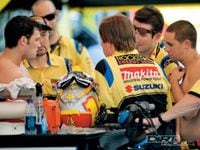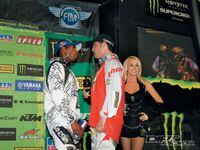Watch the news for too long and the term "economic crisis" will jam its way into your daily lexicon. Keep watching and you'll eventually think nobody in America has a job, every house is being foreclosed on and not a single bank loan is being approved. Given this outlook, the media is persistently reminding us the situation is "toxic" and a "dire emergency," so how could we possibly justify doing something so seemingly frivolous as race dirt bikes? Is this industry immune? Are the original equipment manufacturers (OEMs) still posting record sales? Are the racing budgets as unlimited as titanium parts on a full-factory 450?No. No. And no.According to a February 2009 press release from the Motorcycle Industry Council (MIC), the off-highway motorcycle market dropped off 30 percent in 2008, and word around the shops is the first months of 2009 are just plain scary. Industry insiders say they've been hearing a new phrase in the pits: "Does that fit in the budget?"First, The Good News
It may seem like we already broke the bad news with the report on decreased bike sales. A harder, historical look reveals the industry experienced 14 years of rising sales from 1993-2006 and total sales of all new motorcycles and scooters topped the one million mark for six straight years leading into 2008, beating the record sales from 1970-'74, according to the MIC's Press Relations Manager Ty Van Hooydonk."I know a lot of other industries that would love to have those numbers," he said. "Twenty years ago, motorcycle sales were a quarter of what they are now."With "economic crisis" keeping new models on the showroom floor longer, a lot of riders are taking the iron they already have and making it last longer. One company that's experiencing a record year in sales is Dubach Racing Development (Dr.D), an aftermarket performance engineering firm led by former Yamaha factory star Doug Dubach. Terry Beal, Dr.D's vice president of sales and marketing, experienced that aforementioned 14-year industry surge while working for companies like O'Neal Racing and Yamaha Motor Corporation U.S.A. He has a sharp sense for what feeds the industry, and right now that's keeping old bikes looking new. Beal said January '09 was their second highest month ever and that by February 4 they had 60 percent of that month's goals already committed to paper."The aftermarket companies are doing pretty well," he said. "We're a growing company, and people are upkeeping and upgrading their bikes. Doug and I agree this is no time to slow down. If you get scared, you'll shrivel up and die. When things turn, you'll be at the front and you can take advantage of it."Other than some examples of strong aftermarket sales, there are factors that show our sport is still popular. The attendance at the first 10 rounds of the AMA supercross season was no indicator of a troubled economy.According to one Feld Entertainment Motor Sports official, the series' promotions body, there was a slight scare before the opener in Anaheim when advanced ticket sales were weak. However, the walk-up crowd on race day was strong, the posted attendance actually topped the 2008 numbers by 700 seats and the crowd was less than 3000 shy of a sellout. Phoenix, one of the economically hardest-hit cities in the country, did see almost a 20 percent drop in attendance from 2008, but the numbers picked back up all the way through Daytona and the series set a record in Indianapolis at the new Lucas Oil Stadium with over 61,000 fans.Supercross has long been known to offer the $10 ticket, but Feld officials don't release how many tickets are offered at specific price points. Another selling point is that, compared to other major league sports like the NFL where tickets go into triple digit costs for comparable seats, supercross is more affordable and the accessibility to the athletes is better. It seems it's a working man's sport, even if they aren't working.If the quality of the competition and the loyalty of the fans during the supercross season was an indicator, then the AMA Motocross Championship may optimistically see major high notes in 2009.The sport survived the tough recessions of the mid-'70s and early '80s, but in today's market, the outdoor series seems to be thriving months before the first moto ever takes off as the new promoter, MX Sports, has made announcements and additions to the series almost weekly. The 2009 season will see more changes in one year than the sport has received since its inception in 1971. The major announcements included a bold move to a one-day, Saturday-only format, a television package split between Speed TV and NBC that will air six of the 12 races live and a new title sponsor in Lucas Oil, the same name that adorns the stadium where the NFL's Indianapolis Colts play. The goal, according to MX Sports officials, was maximum exposure to keep the top riders in the sport while keeping the budgets of the teams and local riders in mind."This isn't going to last forever," said Davey Coombs, vice president of MX Sports. "By investing now we feel it will help our teams, sport and industry. We don't want the top riders and teams to look at the series and say, `We're just going to race supercross.'"For the fans, Coombs said the whole atmosphere is being changed from an event to a festival with attractions outside of practice and motos."We're trying to make this more of a happening than just a race."
The Bad News
One of the biggest shocks to the racing community had to be the suspension of American Suzuki's amateur support system and pro contingency program. The initial announcement was short; the programs were simply no more."That was unfortunate," Glenn Hansen, American Suzuki's national communications manager, said of the way the original announcement was made. "It was poor communication on our part because we are going to support some amateur racers. We need to look at the cost efficiencies across the board, what is vital and what we can pull back from. Amateur and contingency reductions were part of that."In February, Suzuki announced that it will, in fact, support an abbreviated amateur program in 2009 with 16 riders. In 2008, its rider support list consisted of nearly 30 pilots from across the country.The other sting delivered by Suzuki was the slash in contingency payouts. Suzuki's overall contingency program was cut by 73 percent, or $7.2 million, from 2008. The biggest hit was the elimination of money for the AMA supercross, motocross and arenacross series. Also missing was the $193,050 for the AMA Air Nautiques Amateur National Motocross Championships at Loretta Lynn's, the biggest amateur motocross race in the world. Suzuki's total investment in amateur racing contingency in 2009 will be $2.6 million."We are focusing our contingency support on the most `grass roots' of the amateur racing arena," Hansen said. "Of course, we had to make some changes to the plan for 2009, and we wanted to focus contingency money in a different area to spread the support as widely as possible."Other OEMs like Honda have also quietly pared down their contingency programs to save money. In 2008, the Red Riders boasted a more than $10 million payout program for all racing disciplines, including road racing. Adding up the 2009 numbers show a 36.5 percent decrease in prize money.As an example of exactly how all these cuts are affecting the sport locally, take Kevin Kelly of DMXS Radio fame. He also runs two motocross tracks in Georgia, the Bremen Motocross Park and the Calhoun Supercross. He said he has steadily seen attendance at his races decline over the past two seasons and the summer of 2008 was the slowest in 20 years."We had some huge years leading into that, though," Kelly admitted. "Now, we are redirecting our focus to more practice days. People aren't racing as much, but they still want to ride. That's the trend we're seeing. They've tapered off their every weekend racing and only do the bigger races."Kelly also runs the six-race Georgia Moto Madness series. It is dealing with Suzuki pulling out its $42,000 from that series.The jobs that are lost specifically in the motorcycle industry don't have the "zing" to make the evening news, but they still sting. The hardest hit are the dealerships and accessory shops. A product rep who spoke on condition of anonymity said he went through a week-long stretch west of the Mississippi River where every single shop visited was laying off employees. Suzuki's Glenn Hansen said they estimate that half of their customers still pay for new bikes in cash, which means the other half are using credit. Tighter credit means more bikes on the showroom longer. Top that with the Consumer Product Safety Improvement Act of 2008, a law that bans all products (including motorcycles and ATVs) designed for children ages 12 and under which contain lead over specified limits, and dealerships have experienced another unplanned, unprecedented crunch.Alex Baylon, founder of MotorcycleIndustryJobs.com, said he has the unfortunate scenario of more workers needing jobs than companies wanting to hire them."I'm about 75 percent down in sales and available jobs from last year," he said.
Why Race?
With more economic land mines predicted to be on the horizon, why race at all? Honda pulled out of Formula One racing due to a budget shortfall. Subaru and Suzuki both pulled out of the World Rally Car Championship, and American Honda withdrew its team from the AMA Superbike Championship because, "current economic conditions led us to take this action," according to a press release issued mid-December 2008.Honda admittedly races to win, but looking back at its automobile racing history, it also knows when it can't win. The Formula One pullout isn't the first in the company's history. It is its third.Despite an absence in roadracing, American Honda has maintained a strong presence in AMA supercross and motocross. When asked how it can justify racing when other divisions of the company can't, American Honda's Motorcycle Press Division said racing is fundamental to the company's DNA. "We're never satisfied with the current results, whether it's winning a race, writing a service manual, creating a brochure, developing higher-quality fasteners--we always strive to do better than the last time. The same attention to detail that you see in the Honda Red Bull Racing CRF450R can be found in everything we do. The words `good enough' are not part of the Honda vocabulary on the racetrack, on the engineer's drawing board or on the assembly line. In this context racing as a channel to deliver our brand identity, to communicate who we are, is easy to justify."It was difficult to get an answer to our question of whether or not the economy has been used as a scapegoat to greater problems within some companies and the industry.Fred Bramblett, founder of OMS Sports, says that, as an industry, we're too entrenched in racing to give up on it."Racing is the greatest opportunity for branding in motorsports," he said. "We're an industry of enthusiasts, and we equate how the bikes perform on the track to how they sell on Monday."Bramblett has personal experience in proving his point. In 1990, he was the mechanic for Scott Summers on the GNCC circuit. It was the first of Summers' five championship seasons, and he chose the Honda XR600, an air-cooled bike that was more suitable for wide-open desert racing than the tight and technical woods found on the GNCC's East Coast-based series. Summers was also lining up against the lighter, more responsive two-strokes. The bike, according to Bramblett, was nearly extinct as Honda had moved to discontinue it. But when Summers started winning races, and eventually championships, demand for the bike surged for the next decade until it was replaced by the XR650, another championship-winning bike in Baja competition."Racing absolutely sells bikes," Bramblett urged. "And if you want a more recent example, look at Yamaha in 1997 when it won a supercross in the first year of having a four-stroke in the sport. The reality is racing puts brands in front of the dealers and customers. If the customer equates that brand with success, that will make a difference in what he or she purchases."The MIC keeps a yearly measure of the reasons people ride motorcycles. Number two on that list is for transportation and commuting, something that the OEMs can't use as a selling point for the high majority of their off-highway lines. That leaves racing as a primary means of product promotion. But according to sources close to the teams, a factory SX/MX yearly race budget for two to four riders runs from $7 million to $15 million, depending on the size of the OEM."If you were to look at our SX team, for example, and what it costs us to fund the program and put that up against the number of units sold, that's a lot of money per bike in comparison," Suzuki's Hansen said. "You have to throw in the television exposure, nonenthusiast media exposure and all the great sponsor opportunities and the relationship with companies like Makita and the benefits that has. If some guy is looking for power tools and goes on the Makita website, he sees Ricky Carmichael and Chad Reed. That's a cool connection and priceless exposure. Those connections go further and further in these multiyear sponsorships, further than just sales numbers."Racing is going to happen, whether the fans realize the hardships facing the companies or not. Cuts will be made but the gate will drop. NASCAR isn't immune to it. Sponsors have pulled support, and NASCAR has suspended all testing at its sanctioned tracks in a cost-cutting measure to help teams save millions in their 2009 budgets. Such cuts in the motorcycle industry aren't as public but they're there."We're cutting staff at the track, only sending personnel that needs to be there, looking for better hotel and airline rates," said David Evans, founder of MX Edge, an independent consulting firm that lists Joe Gibbs Racing as a client. "However, if it makes the bike better or the rider faster, it won't get cut."Fred Bramblett said the cost cuts are across the board but everyone is still going racing, just not at the same level. "At the conventions and shows, there is a downsize in booths. In racing, any responsible manager is looking hard at all nonessential costs. You have to enjoy the good times because nothing lasts forever. Right now, it's raining."Racing for a championship is not predictable, and neither is the economy. The Dow Industrial Average is up 500 points one day and down 600 the next. How can one make sense of something so frantic, volatile and "all over the map"? Don't be any of those things. What does it mean when Bridgestone stops coming to the races, Suzuki slashes contingency and overall bike sales are down, yet supercross attendance is strong, GNCC and WORCS entries are up and Dr.D's business is booming? It means that people are still riding, just not on brand-new tires or bikes. It means that people are still racing, but they're sticking a little closer to home. The evening news tells us that an astonishing 12 percent of all homeowners with mortgages are behind at least one payment. What the news fails to tell us is that 30 percent of all home owners have no mortgage debt at all. We ride, race and spectate for enjoyment, and it's difficult to watch our entertainment affected by the negative reality of current events. Sitting at home on the weekends won't help anyone prosper; not the small promoters or the big OEMs. Being active doesn't require "bold new graphics" or the latest replica gear. Motorcyclists have figured that out because they're a strong enthusiast group. Only this time, they're keeping closer tabs on the budget.




/cloudfront-us-east-1.images.arcpublishing.com/octane/EXJM3ZOP5JGOFL2BNU2G6KCGX4.jpg)
/cloudfront-us-east-1.images.arcpublishing.com/octane/2VHGWMYT4RE33JOHF3ATQ4CWBY.jpg)
/cloudfront-us-east-1.images.arcpublishing.com/octane/MAA7CTOAVJEH5H5QNC45LBIHPM.jpg)
/cloudfront-us-east-1.images.arcpublishing.com/octane/NOJSQ77E2BHR3IMKEJPCENML4A.jpg)
/cloudfront-us-east-1.images.arcpublishing.com/octane/B5QDMPSPWRA3RBBQJUC4FNI4JI.jpg)
/cloudfront-us-east-1.images.arcpublishing.com/octane/B3BPW2WOCNCUZPL2QVICQUC4VU.jpg)
/cloudfront-us-east-1.images.arcpublishing.com/octane/MLFO3UACYFHHLLP7WUYGUCFCBI.jpg)
/cloudfront-us-east-1.images.arcpublishing.com/octane/RS3JKVKIG5H2TFBCQXCLFWSJ6Q.jpg)
/cloudfront-us-east-1.images.arcpublishing.com/octane/6ONR4CR3FBB5PDN5SQPFB36CSI.jpg)
/cloudfront-us-east-1.images.arcpublishing.com/octane/3GF26TF5YVFIJCHZJMYTMWIPPY.jpg)
/cloudfront-us-east-1.images.arcpublishing.com/octane/QSWIPGJUFNAENBSGFG5ASKGUCY.jpg)
/cloudfront-us-east-1.images.arcpublishing.com/octane/JEB56YXHFZDYRBTQRSUPSIQT4E.jpg)
/cloudfront-us-east-1.images.arcpublishing.com/octane/2U42JYK7ZVCK5FISIIFYDLMFQY.jpg)


/cloudfront-us-east-1.images.arcpublishing.com/octane/2F2YWJRM4ZDCBEBIHI6HAZXI5U.jpg)


/cloudfront-us-east-1.images.arcpublishing.com/octane/I37LN27L3ZHRHO6DZRHHBLBCZQ.jpg)


/cloudfront-us-east-1.images.arcpublishing.com/octane/77ZEF3VNXZFIHI5IUF6ZBEHEJE.jpg)
